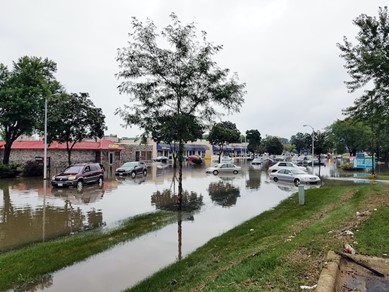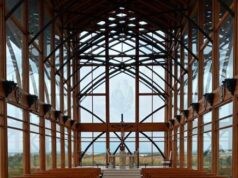David DeQuattro is a well-established architect. In the following article, David DeQuattro discusses how climate change is impacting the architecture and engineering industry with an understanding of the intricate interplay between built environments and the natural world, uncovering the transformative strategies that are poised to reshape the way we conceive, construct, and inhabit our built environments.
Hotter summers, warmer winters. More frequent storms. Heavier downpours. Some drought-blighted regions. Two words sum up the effects climate change is having on the world: extreme and unpredictable. As some areas warm considerably and others scuttle to below-freezing temperatures, buildings, alongside their architects and engineers, are constantly put to the test.
While those less in-the-know may be quietly basking in the generally warmer weather, the change is anything but good news. According to the authors of Adapting Industry to Withstand Rising Temperatures and Future Heatwaves, Dr Tim Fox and Dr Laura Kent, the continuously increasing frequency of heatwaves negatively affects buildings, equipment, and personnel, causing reduced efficiencies and operational failures.
David DeQuattro explains that from more likely corrosion and deterioration to boosted wind and snow loads to changes in structural burdens from the rising sea levels and incalculable temperature swings, modern architecture must be meticulously designed and constructed with ever-advancing technology to withstand the grueling trial that is climate change.
David DeQuattro Says Unprecedented Temperature Fluctuations Impede Structural Safety
Undulating temperatures alter material properties, expanding and contracting them in fundamental yet often unnoticeable ways. David DeQuattro explains that temperature distributions depend on the re-radiation, long-wave radiation, wind speed, and shadow air temperature, but as the world’s climate continues exhibiting unpredictable tangents, these factors are becoming harder to forecast in the long-term, compromising building safety.
Temperature influences cause strain at the molecular level, with elemental deformation becoming a particular concern in some areas — the sun may warm just one side of a structure, resulting in torsion throughout its cross-section.
Ultimately, David DeQuattro says that buildings could be at risk of collapse in many parts of the globe, as climate change relentlessly skyrockets the Earth’s surface temperature.
Extreme Weather Prompts the Creation of Waterproof Veneers and Floating Structures
David DeQuattro notes that the oceans are heating up, affecting hurricanes, eliciting tropical storms, raising sea levels, and bringing increased wind speeds. Not only does this cause extra coastal damage, but it weakens previously hardy buildings in various locations. While erosion was once just a shoreline concern, the horrendous downpours are moving the problem in-land.
Over the past few years, professionals have focused on flooding related to storm surges and heightened sea levels. However, David DeQuattro notes the recent awareness that rain-related floods are growing more frequent. The aforementioned downpours are dropping larger volumes of water in shorter periods and are typically followed by drought-like periods.
The conundrum has the architecture industry in a tailspin — sea walls may stop the flow of the ocean, but they’d act as a dam for storm water. Either way, flooding certainly isn’t going anywhere.
To combat the otherwise wholly detrimental occurrence, architects and engineers are crafting floating structures that anchor to the seafloor, enhancing their fortification while relaxing into Earth’s natural ebbs and flows. Perhaps unsurprisingly, such professionals are utilizing flood-resistant materials in their designs to reduce their fragility in wet conditions.
David DeQuattro says that engineers are beginning to add waterproof veneers to buildings around the world, protecting the materials and the internal structure. Not to mention they’re using ceramic tile, foam insulation, and other water-resistant materials to reduce general damage and rot, while advising electricians to install raised systems to reduce fires.
These industry changes aren’t just essential for resource conservation, but also for safety of life and limb in this ever-warming world.

The HVAC Challenge
Heating, ventilation, and air conditioning (HVAC) systems are lauded for their ability to keep dwellers comfortable, regardless of external conditions. However, their famed ability is failing under the weight of climate change’s humidity, temperature, and air quality fluctuations.
David DeQuattro explains that the hotter summers are demanding longer run times at higher capacities, placing a significant load on system components and causing higher energy consumption and boosted wear. Combine this with the extreme weather events, and HVAC units are experiencing more equipment damage, power outages, and other disruptions than ever before.
Humidity is also a major concern for these systems. Altering indoor air quality favors mold growth and similar pollutants, while dust storms and wildfires pump outdoor nasties into inside environments.
Resiliency: A Crucial Focus Area for All Structures Going Forward
David DeQuattro says that whether it’s through buildings with waterproof veneers or HVAC systems with energy-efficient technologies and advanced air filtration, architects and engineers alike must focus on structural resiliency to keep society ticking as the dreadful impacts of climate change realize themselves across the world.
Reference Sources
https://www.construction21.org/articles/h/the-impact-of-climate-change-on-building-design.html https://en.klimatilpasning.dk/sectors/buildings/climate-change-impact-on-buildings/ https://www.gcelab.com/blog/impact-of-climate-change-on-civil-engineering https://www.imeche.org/news/news-article/feature-meltdown-the-race-to-engineer-better-buildings-for-a-warming-world https://www.engineering.com/story/how-are-buildings-and-infrastructure-changing-in-response-to-climate-change https://medium.com/@davidcarter2922/the-impact-of-climate-change-on-hvac-systems-2450c1977ace









